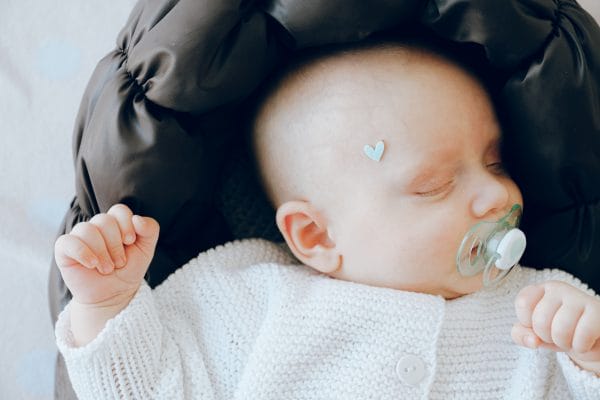How to Keep Your Baby Warm at Night: Tips for a Warm Night
Ensuring your baby is warm and comfortable at night is crucial for their health and well-being. However, it’s often a concern for parents, especially during the colder months.
In this article, we’ll explore various strategies on how to keep your baby warm at night, taking into consideration the recommended room temperature for babies and baby sleep temperature guidelines.

Table of Contents
Understanding the Importance of a Warm Sleep Environment
![]()
A warm sleeping environment is essential for a baby’s safety and comfort. Babies are less able to regulate their body temperature compared to adults, and a cold sleeping environment can lead to issues such as hypothermia or an increased risk for Sudden Infant Death Syndrome (SIDS). Conversely, overheating is also a risk factor for SIDS. Thus, maintaining the right balance is crucial.
Recommended Room Temperature for Babies
![]()
The recommended room temperature for babies is generally between 68 and 72 degrees Fahrenheit (20 to 22 degrees Celsius). This range provides a comfortable and safe environment for infants to sleep in. It’s important to monitor the room temperature with a reliable thermometer to ensure it stays within this range.
Baby Sleep Temperature Guidelines
![]()
Baby sleep temperature guidelines suggest dressing your baby in light, breathable layers that can be easily adjusted based on the temperature of the room. As a rule of thumb, dress your baby in one more layer than an adult would wear to be comfortable in the same environment. However, avoid overbundling as this can lead to overheating.
How to Keep a Baby Warm at Night
![]()
There are several strategies to keep your baby warm at night without risking their safety. Here are some key methods:
- Appropriate Clothing: Dress your baby in a suitable onesie or sleep sack that is appropriate for the room temperature. Ensure the fabric is breathable, such as cotton, to prevent overheating.
- Layering: Use layers to keep your baby warm. A base layer followed by a sleep sack or a swaddle is usually sufficient. Adjust layers according to the temperature.
- Safe Bedding: Keep the crib free of loose blankets, pillows, and toys. Use a fitted sheet and, if needed, a baby sleeping bag or wearable blanket designed for infants.
- Room Temperature Control: Maintain the room temperature using a heater with a thermostat or an air conditioner. Consider a humidifier if the air is dry, as it can help maintain warmth.
- Warm Bath Before Bed: A warm bath before bedtime can raise your baby’s body temperature, helping them feel cozy as they fall asleep.
- Physical Contact: Skin-to-skin contact or cuddling before bedtime can help raise your baby’s body temperature and comfort them.
How to Keep a Baby Warm at Night in Winter
![]()
During winter, the challenge of keeping your baby warm at night increases. Here’s how to address this:
- Room Insulation: Ensure that the nursery is well-insulated. Check for drafts around windows and doors and use draft stoppers if necessary.
- Extra Layers: Consider a long-sleeved onesie under a sleep sack. Always ensure the materials are breathable.
- Heating Devices: If using a space heater, make sure it’s safe for use in a child’s room and keep it away from any flammable materials.
- Warm Accessories: Use a cap and socks if needed, but make sure they cannot come off easily during sleep.
Monitoring Your Baby’s Temperature
![]()
Keep an eye on your baby to ensure they are not too hot or too cold. Signs that your baby may be too cold include fussiness, cold hands and feet, and a cooler chest. Signs of overheating include sweating, damp hair, flushed cheeks, heat rash, and rapid breathing. Adjust layers and room temperature accordingly.
Practical Case Studies and Examples
![]()
Case studies have shown that babies who sleep in environments that are within the recommended temperature range experience better sleep patterns and reduced risk of sleep-related issues.
For example, a study published in “Pediatrics” found that a well-regulated sleep environment reduced the instances of wakefulness in infants. Another study highlighted the importance of using the correct tog (a measure of thermal insulation) in baby sleepwear to prevent overheating, particularly in winter months.
Frequently Asked Questions
![]()
How should I dress my baby for bed in cold weather?
Dress your baby in layers, which can include a onesie, followed by a sleep sack or wearable blanket. Don’t overbundle; the layers should be just enough to keep them warm without overheating. You can use one more layer than you would wear to be comfortable.
What is the ideal room temperature for my baby’s room?
The ideal room temperature for a baby’s room is between 68 and 72 degrees Fahrenheit (20 and 22 degrees Celsius). This is comfortable and safe for your baby to sleep in.
Can I use a blanket to keep my baby warm at night?
It’s best not to use loose blankets with babies under 12 months because of the risk of suffocation or Sudden Infant Death Syndrome (SIDS). Instead, use a wearable blanket or sleep sack.
How can I tell if my baby is too cold at night?
Feel your baby’s neck or back (not hands or feet, which are often cooler). If the skin is cool to the touch, your baby might be too cold. Another sign could be if your baby is fussing more than usual and can’t be comforted in other ways.
How can I tell if my baby is too hot?
Check your baby’s neck, back, or tummy, which should feel warm, not hot or sweaty. If your baby is sweating or has damp hair, remove a layer of clothing or adjust the room temperature.
What kind of sleepwear is best for keeping my baby warm?
Opt for sleepwear made from breathable materials like cotton. Look for one-piece sleepers or wearable blankets that are appropriate for the season and the temperature of the room.
Is it safe to use a space heater in my baby’s room?
Space heaters can be dangerous due to the risk of fire or burns and can make a room too hot. If you must use one, keep it well away from the baby and never leave it on unsupervised or while everyone is sleeping.
How often should I check on my baby during the night to ensure they are warm enough?
You don’t need to wake up your baby to check their temperature, but if you’re concerned, you can check once before you go to bed and each time you get up for feedings.
Can my baby sleep with a hat on to keep warm?
No, it’s not safe for babies to sleep with hats on indoors as they can overheat or suffocate if the hat slips down over their face.
What else can I do to keep the room warm without overheating my baby?
You can use a room thermometer to monitor the temperature. If the room is cooler, try insulating it with curtains or draft excluders on doors. A humidifier can also help make the room feel warmer and more comfortable.
Conclusion: Key Takeaways for Keeping Your Baby Warm at Night
![]()
Ensuring your baby is warm at night is a delicate balance that requires attention to their clothing, the room’s temperature, and monitoring for signs of discomfort. Remember to:
- Keep the nursery at a recommended temperature between 68-72 degrees Fahrenheit.
- Dress your baby in breathable layers that can be adjusted as needed.
- Avoid loose bedding and instead use fitted sheets and appropriate sleep sacks or swaddles.
- Be vigilant for signs of overcooling or overheating, and adjust your baby’s environment accordingly.
- Follow baby sleep temperature guidelines to ensure a safe sleep environment.
By following these guidelines and tips, you can create a cozy, safe, and warm environment to help your baby sleep soundly through the night, regardless of the season.
Originally posted 2023-04-26 04:30:10.
